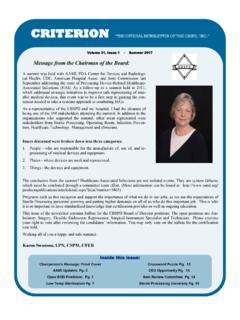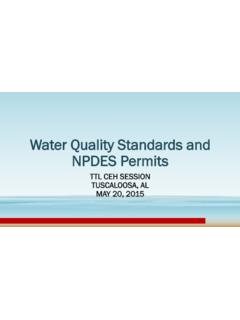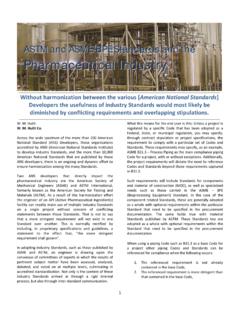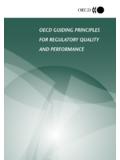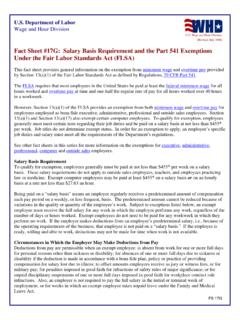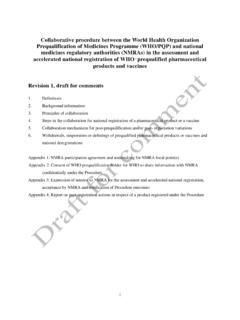Transcription of A Quality for Service - Cbspd
1 ISO Training ProgramAQualityControlProgramforCentralS erviceSupported byNew Jersey Department of Health and Senior ServicesandNew Jersey Health Care Central Service AssociationandMid-Atlantic Central Service Association ISO Sub-Committee Authors Pat Bain, RN, CIC Infection Control Coordinator Englewood Hospital 350 Engle Street Englewood,NJ 07631 Bob Brockson CSR/OR Technician Hunterdon Medical Center 2100 Wescott Drive Flemington, NJ 08822 Anne Cofiell, CRCST, FCS 703 Country Club Parkway Mount Laurel, NJ 08054 Nancy Chobin, RN, CSPDM Saint Barnabas Health Care System Livingston, NJ 07039 Donald L. Hatfield Director Central Sterile Supply South Jersey Hospital 65 South State Street Vineland, NJ 08360 Maureen L. Lelko, RN, CSPDT Manager, Central Service Warren Hospital 185 Roseberry St Phillipsburg, NJ 08865 Teckla A.
2 Maresca, LPN, CSPDM Manager Central Service Saint Clare's Health services Pocono Rd. Denville, NJ 07801 Anthony Monaco, MA, HO New Jersey Department of Health and Senior services PO Box 369 Trenton, NJ 08625 Rosemary Perry, RN, CIC Infection Control Coordinator Holy Name Hospital 718 Teaneck Road Teaneck, NJ 07666 Nora Wikander, RN, CSPDM Director SPD Saint Joseph s Wayne Hospital 224 Hamburg Turnpike Wayne, NJ 07470 Carol Wicki, RN, CSPDT Central Service Hackettstown Community Hospital 651 Willow Grove Street Hacketstown, NJ 07840 Fred Wycoff Director Central Sterile Supply South Jersey Hospital 65 South State Street Vineland, NJ 08360 ISO Sub-Committee Contributors Thomas Bishop SPD Director Atlantic City Medical Center 1925 Pacific Avenue Atlantic City, NJ 08401 Susan Campano Deborah Heart & Lung Hospital 200 Trenton Road Browns Mills.
3 NJ 08015 Jacqueline Donnelley Warren Hospital 185 Roseberry Street Phillipsburg, NJ 08865 Diane Eby Kessler Memorial Hospital 600 South White Horse Pike Hammonton, NJ 08037 Sue Ellen Erickson Perioperative Educator Newark Beth Israel Medical Center 201 Lyons Ave. Newark, NJ 07112 Carlene Evans Monmouth Medical Center 300 Second Avenue Long Branch, NJ 07740 Mary Lesica Central services Supervisor Chilton Memorial Hospital 97 West Parkway Pompton Plains, NJ 07444 Terri Matthews, RN, CNOR Director of PT Care/CSP Community Medical Center 99 Route 37 West Toms River, NJ 08755 Patricia Musialowski Director of Sterile Processing Somerset Medical Center 110 Rehill Avenue Somerville, NJ 08876 Elizabeth Myers Chilton Memorial Hospital 97 West Parkway Pompton Plains, NJ 07444 Sue Nitshe President Mid-Atlantic Central Service Assn.
4 77 Hackett Road Woostown, NJ 08098 Barbara Olive, RN SPD Department Atlantic City Medical Center Mainland Division Jimmie Leeds Road Pomona, NJ 08240 Glenda Santiago Warren Hospital 185 Roseberry Street Phillipsburg, NJ 08865 INTRODUCTION Quality assurance systems have been applied to many services within health care facilities, often leading to great confusion and misunderstanding. The intent of this document is to apply the widely accepted International Standards Organization (ISO) Quality system model to Central services . We believe that this system, which was developed in 1987, is applicable to Central services as manufacturers of sterile reusable instruments and devices. The production of a sterile product encompasses many complex manual and mechanical processes. In today s health care system, the customer base has expanded to include ambulatory care facilities, physicians and even neighboring hospitals.
5 The suppliers of medical devices are manufacturing complex instruments that require specialized cleaning methodologies including specific detergents and equipment. All these factors make the task of documenting a Quality system based upon ISO an important mandate. In order to establish a starting point for Central Service in their quest for a Quality system, it was necessary to identify the primary functions within the department. Thirteen functions common to Central Service were identified. With these functions in mind, you are ready to move on to the first step in creating a Quality system, which is to document your process. Since each hospital provides different services based upon its customer base and its mechanical and physical layout, it is important to develop policies and procedures that are specific to your process.
6 State Regulations and the Joint Commission on Accreditation of Healthcare Organizations (JCAHO) require hospital policies to be reviewed and updated every three years. It is important to follow government regulations as well as national guidelines when developing hospital policy as it provides the means to defend proposed policies and enhances the professionalism and credibility of the manager and department. Policies are broad based documents that provide direction to personnel in all aspects of Central Service such as, but not limited to: receiving; decontamination; preparation; sterilization; storage and distribution. Government regulations are minimum standards that must be met and may differ from national standards or guidelines. In cases where they differ, the more stringent of the two should be selected.
7 Each chapter of this document references the state and federal regulations as well as the national guidelines that should be utilized when creating or revising hospital policy. In order to develop meaningful policies, it is necessary to obtain the most current versions of these regulations and standards. Once you have the current regulations and standards, you need to compare existing hospital policy to these guidelines to determine discrepancies and correct them. Once policies have been reviewed and/or revised, they must be submitted through your organizational chain of command for final adoption. In most cases, revisions will be submitted to the infection control committee and or safety committees for review and approval. The next step in establishing a Quality system is to develop specific work practices or procedures.
8 Staff involvement is critical to developing procedures for each step of the manufacturing process as you will be asking them to document how they perform their duties on a daily basis. There are many different approaches to accomplish this task. However, the following method may prove to be the easiest. First, choose a procedure and have your employees develop a handwritten flow chart of each step in the process. It is best to begin with a basic process and avoid unusual, or special situations such as an OR emergency, loaner instrumentation, or portable patient care equipment. These situations require deviation from the normal process and should be avoided until the basic process is developed. Specific flow charts will need to be established for each situation. Once a flow chart has been established for each step of the manufacturing process, employees should provide a written description of exactly what they do at each step of the flow chart.
9 In essence you are looking for: what to do, when to do it, and who and what are needed to do it? Once the current work practices have been developed, and flow charts developed, a review process should be performed by management and staff. The department s work practices should be compared to the ISO outline in this document to ensure that all issues are covered. At the same time, work practices can be compared to hospital policy, state and federal regulations, and national guidelines. By including staff in the process of comparing their work practices to outside sources you are empowering them to identify problems and improve practices. Management and staff should review existing work practices looking for the following: 1. Poor work practices. 2. Short cuts. 3. Duplication of effort.
10 4. Staffing shortfalls. 5. Special requirements for specific products. 6. Additional training/in-servicing needs for staff. 7. Compliance with State and Federal regulations as well as national standards. As part of this process, each should prepare recommendations for change. Consideration of customer needs is also a major component of the Quality system process. The department s ability to satisfy its customers needs on a consistent basis is the first step towards being considered reliable and professional by your organization. In each section of this ISO guidance document, key players are identified. Although it is the manager s responsibility to work with the department s customers to identify their needs, at least one staff member should be included in the process.
